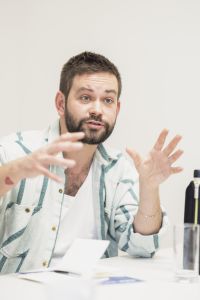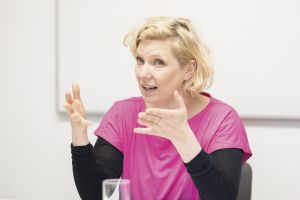Brutpflegerinnen members Eva Puchner and Susanne Preissl, mdw graduates Golnar Shahyar and Simon Scharinger, and Department of Folk Music Research and Ethnomusicology head Marko Kölbl discuss whether art has to be political and the contexts in which it can support protest movements.
Artistic manifestations of protest can be found in all languages, historical eras, and regions. What gives rise to this close connection between protest and culture?

Susanne Preissl (SP): The arts are very well suited because they enable protest to be lodged in a subversive way while avoiding direct confrontation. To this end, we go for emotions—because doing so triggers people on a less rational level. That’s the great opportunity and potential of the arts in the realm of protest.
Golnar Shahyar (GS): Art is also the language of solidarity. It’s an emotional language and embodies forms of expression that reflect our feelings, our worries, and our identities. What’s more, it provides us with visions. And by coming together, we strengthen ourselves as a community—which is what ultimately makes art and music so powerful: they bring people together.
Eva Puchner (EP): Moreover, involving art serves to engender shared, playful attentiveness. Before people hit the streets in the climate protests, they met up to create posters and banners together. That made an essential contribution to the public’s awareness of those protests.
Marko Kölbl (MK): Alongside music as a form of onstage art, one can also conceive of it as everyday practice. At protests, the point is to send a message. When you take to the streets with the intent of getting this or that content across, putting it to rhythms and melodies is a natural thing to do. That kind of music is participative and democratic; everyone can be part of it, regardless of whether they’re great singers.
Do protest songs work so well because everyone can sing them?
MK: Yes—because they’re participative, but also because they stand for something.
GS: Protest songs with a direct message need to be understood by a broad audience. You have to be able to move to the rhythm no matter how musical a person you are. The melodies need to be easy to sing and connected in some way with existing cultural memories. And if you combine all that with meaningful lyrics, you’ve got a successful protest song.
Is there any particular art form or genre that’s particularly well suited to protest?
MK: Melodic chanting of demands at demonstrations could almost be considered a genre in its own right. And onstage, you can find protest in nearly all genres—with only classical music being less strongly represented.
GS: Protest songs do get performed onstage, and signals of support do come when crises and directly related socio-political themes are at issue. But one mustn’t forget the fundamental problems within the system, and in this respect, another type of resistance work exists that’s being done by artists who focus on such chronic and systemic problems. I’m thinking of discrimination, colonialism, and capitalism, which cause a whole lot of other art forms to be excluded. This type of resistance should also be considered protest. It’s difficult to position a vision in the present context, which is why art that challenges the system is so important.
So is it the responsibility of artists to take a stand on societally relevant themes? Does art have to be political?

Simon Scharinger (SS): Well, I’d say that it should at least try to be. As artists, we have a stage available to us and the ability to attract attention—and neglecting to make use of these things means wasted potential.
MK: I don’t think, though, that artists have to be socio-politically engaged, even if I do like artists who are—above all when what they’re doing matches my own political views. And there are enough artists who are and/or want to remain apolitical. But what I do have difficulty with in this context is the exaltation of artistic personalities and this assumption that they’re not permitted to make mistakes or have political views that deviate from one’s own. Andreas Gabalier, for example, has taken a stand against gender-inclusive formulations in our national anthem—which is also a form of protest.
GS: Art is a socio-political thing that shouldn’t rest on the shoulders of individual people. How can I link music and other forms of cultural expression with social or political themes? We should make a theme of that. And what’s our mission in doing so? Unfortunately, this isn’t happening on the institutional level. Art and high culture are kept separate from social and political themes. But the power of music lies in communication and connection, which cause people to feel either excluded or included. And it’s institutions’ job to subject artists to this discussion in order to create an awareness in this respect.
EP: In my view, we have an obligation to use our art in order to highlight things that are going seriously wrong. And I can remember one moment in the course of political events where the urge to raise our voices was so great that it was impossible to do otherwise.
Which means that artists process themes that preoccupy them and are hence per se socially critical?
SP: It can’t work any other way. Eva and I only ended up finding each other because we had the need to say something, to express ourselves. We got to know each other at the IKM, the mdw’s Department of Cultural Management and Gender Studies, which is also where we also conceived and developed our programme. As people who do a lot of work in the feminist context, we put some thought about how we could position our statement. We quickly realised that we had to shift from the stage to open spaces—for reasons including how it’s there that you encounter people whom you wouldn’t meet at a theatre. People who have zero intention of engaging with art. All this grew out of an original desire to combat unequal treatment on the basis of gender.
What’s been your experience, protesting in public spaces? How do such things land?
EP: It differs; sometimes we receive feedback where it’s about empowerment, where we’ve inspired women to keep fighting and also share their stories with us. That’s wonderful. But we also experience negative, even aggressive behaviour towards us—mainly from men. There was one situation that I remember particularly well. We were spending a week positioned on Karlsplatz for a performance. The first day, a young man asked us what we feminists were even doing here and whether we were out of a job. But a couple days later, he came back and told us that he’d gotten informed about our topic and that what we were doing wasn’t so bad. That experience was only possible because we’d stayed in one place for a long time.

What’s necessary in order to be able deal with these important themes as an artist in the first place?
GS: It takes not only an incredible amount of time and energy to become an expert in the field of music but also even more knowledge and energy in order to get familiar with the music business and hold one’s own in it. That’s why musicians are typically overloaded and have very little time to concentrate on anything but the survival of their art as such. And as a freshly trained musician, you’re too politically and socially weak to take a stand. Instead, you have to put up with everything. So when we speak of socio-political engagement in the arts, we have to be sure to shape our system such that freelance artists can actually pursue such engagement.
MK: I’m 100 percent with you, here—which is why I think we need to insist that institutions assume this socio-political responsibility.
SS: That’s exactly it: nice words are not enough. Important messages and political positions are often conveyed exclusively in press conferences; in a structural sense, however, the status quo remains as is. So we have to learn to distinguish between superficial cosmetic surgery and action that promotes real change—and to drive forward and cultivate this type of protest.
What does that mean in a concrete sense?
SS: It means various things, but above all working on oneself. Protest always begins with the little stuff: with questioning one’s own structures and patterns, with putting oneself through the wringer. Protest requires effort, and it’s never-ending; it’s not enough to just post something or stroll along with a demonstration. You can never just check it off and sit back. Quite often, protest does “just” mean being a good ally, providing support in the background and freeing up space for others. But sometimes, saying nothing is also a political act. Every year on 8 March, I get this flood of social media posts by artists declaring their solidarity—but their grandstanding really just serves to occupy the space of other artists. I’m a performer and a musician myself, and it’s often difficult to strike a balance in this respect. In the a cappella music cabaret project Gesangskapelle Hermann, my colleagues and I try to support causes that are important to us—sometimes subversively, sometimes actively, and sometimes by just holding back and showing reserve. But ultimately—and this is something we always need to keep in mind—we’re musicians first and foremost, and our main goal is to entertain and to get people laughing.
EP: One also has to be able to afford protest and find time for it—after all, it’s not always paid. And all the artistic work, engaging with things and learning them, is an intensive process that takes a lot of time.
So can protest also influence one’s career?
EP: Of course, and you do need to be careful. As part of Kill the Trauerspiel, an association that advocates diversity and gender equality on Austria’s stages, I’m repeatedly confronted with the problem of people being unable to engage with this issue out of fear that their political involvement could have negative repercussions in terms of their employment or their artistic work. But it’s especially regarding this issue that institutions are the ones who have to take action. So I think that policymakers have a responsibility, here.
GS: If you want to be politically and socially active, there’s a whole area of knowledge all its own that you need to acquire. You have to devote really intensive study to it; otherwise, it all remains superficial. So I’ll take time that I’d really need for my music and instead attend a seminar in order to get current on the state of discourse. Your art suffers from that, but that’s reality.

MK: So far, here, we’ve been talking about artists who get politicised and take a stand on something. But sometimes, the most powerful act of protest can be to sing a folksong in a language that’s banned or frowned upon in your own country. As a Burgenland Croat myself, I think back to a time when Croatian wasn’t something that people liked hearing. Back then, you were already being radical, automatically political, just by singing a song in your own language.
So it would follow that art also constitutes protest when you practice it in a country where it’s forbidden…
MK: Absolutely. In my research, I’ve been looking at Afghan music and the implicit music ban that’s been in effect in Afghanistan since the summer of 2021. Making music is a violation of the law and hence a form of protest. That goes all the more for women, who seldom made music in the pre-Taliban era to begin with. But the political context can also inject content into forms of cultural expression that one might think are pretty everyday.
Like where?
MK: I’m thinking here of a performance by the Vengaboys on Ballhausplatz after Austria’s turquoise-blue coalition government had fallen. Their song “We’re Going to Ibiza” is a good example of music that doesn’t contain a message of protest per se but took on such a message in the context of specific events—in this case, the Ibiza affair—and thus became political. That song became a hymn of the anti-government protest movement and even ended up topping the Austrian Spotify charts.
So protest art or culture can become so successful that it ends up going mainstream? What does that mean in terms of the issues themselves?
SS: That’s one of those things where I think you have to perceive the greater whole. Insofar as the original thing doesn’t vanish and it all generates an even larger critical mass that can set something in motion in its own right, I think it’s okay. And you don’t have to agree with everything. At the Black Lives Matter demonstrations, I was repeatedly upset by (white) participants who, it seemed to me, were concerned mainly with partying and generating their next Instagram posts. But even so, those people did contribute to that movement’s success. And to be honest, I’ve likewise already gone to demonstrations where I was looking forward to nothing more than spending the time with my friends.
MK: Protesting can and should also be fun.
SP: And for my part, I notice how it’s a good thing when protesting or pursuing our form of art doesn’t stop being fun. Because it’s also not always easy subjecting oneself to the public, because you get negative vibes, too.
SS: And you really do accomplish a lot with fun and enthusiasm. The theatrical world hasn’t quite understood that, yet—or they’ve forgotten about it. If all I do is hold moralising sermons and portray problems one-to-one in a completely obvious way (thereby also reproducing them), I definitely won’t succeed in reaching the audience. And I almost get the feeling that the joyless, accusatory theatre of our era isn’t even intended to reach the audience—that they’re more concerned with checking some supposedly existent box and bathing themselves in virtue. I’m missing the contradictions, the grey areas, the actual stories.
GS: I think that every situation requires its own energy. Art and music have the power to set feelings in motion. I’m thinking of Iran, where rap music has become a channel for pent-up rage; that energy is needed there. It moves the masses and brings them together.
Keeping this idea of the mainstream in mind: we’re noticing how even entire musical styles that were originally protest-focused are getting co-opted and commercialised.
MK: A good example of that is house, which originated in a black, queer, underground setting but then got totally whitewashed and is now the most apolitical genre one could imagine. It’s interestingly how such developments always run along “racial divides”. As soon as a musical style departs from its black origins and starts getting commercialised, it turns into a white musical style. That happens with lots of styles of popular music.

GS: And if one’s socially and politically active at the institutional level, it’s imperative to perceive such things and support communities from which such art has been taken.
What might educational institutions be able to contribute, here?
GS: Lots, but it unfortunately won’t be enough. Even just the knowledge that art is a socio-political act doesn’t exist. That awareness needs to be created. It’s a cultural policy theme, which means that it’s a type of discourse that also needs to play out at the political level.
EP: In actual fact, the idea of protest hasn’t been a theme at classically focussed arts universities. It was only at the IKM that something one of our teachers said inspired me to put my art to political use.
MK: I think it also depends on the art form. In fine and applied art, political work has a long tradition. But it’s not as easy in classical music, since what we’re talking about there is mainly an interpretive art form. It has a canon, and that canon is established: it’s white, male, heterosexual, Christian, European, etc. And it’s about being interpreting the music in a way that’s as correct as possible, which is also something that’s pre-determined. All that leaves little space for any political elaboration, which is why it’s important to reflect upon that canon and subject its fixity and rigidity to criticism. However, I do think that something is changing here at the mdw—as we now see in the anchoring of gender and diversity coursework in all programmes of study.
Mr. Scharinger, you were already working with the topic of protest as a student…
SS: I staged a production of Vaclav Havel’s play Protest for the festival Neues Wiener Volkstheater. Peter Roessler, a professor of dramaturgy at the Max Reinhardt Seminar, recommended this material to me—and I fell in love with it straight off. Furthermore, a lot of things got set in motion internally by my continued investigation of its author, since Havel himself more or less exemplifies how the arts and politics can be linked: as a dissident who wrote plays in prison, as Czechoslovakia’s president following the Velvet Revolution in 1989, and then as the Czech Republic’s first president, he’s an unbelievably fascinating figure, for sure.
Are there any examples from the recent past in which art has effectively supported protest movements?
MK: One that I can think of is the Thursday Demonstrations against the government, protests that all kinds of sound and performative expression allowed to be heard and seen in all kinds of ways. Isabel Frey was there with Yiddish revolutionary songs, there were the rhythmic groups that so often turn up, and there were also those short melodic chants that were improvised on the spot.
Another example would be songs that end up becoming political. The famous Afghan song Sarzamine-man (“My Homeland”), originally a Turkish Arabesque pop number, was about fleeing from the first Taliban regime during the 1990s. It made a comeback amidst the 2015 migrations and again following the Taliban’s renewed rise to power in 2021. You also heard this memorable song played over and over at a major demonstration that was held in support of the right to asylum in Vienna. I think it’s very interesting how certain songs with political connotations keep coming back—for unfortunate reasons, one has to say.
GS: There’s one protest song by the Iranian musician Shervin Hajipour, entitled Baraye, that got recognised at this year’s Grammy Awards. For its lyrics, the singer collaged tweets that people had posted about why they were hitting the streets to demonstrate, tweets expressing very lovely, integrative, inclusive desires. It was about those freedoms that you’re denied living under such a dictatorship. Her song became the anthem of this Iranian revolution and moved the masses. It’s an important example of just how influential a piece of music can be. See this issue’s article “Music as a Voice of Protest in Iran”.
SP: What’s definitely also cause for hope is the graffiti by Banksy in Ukraine that shows a child throwing a judoka to the ground. It’s a pointed reminder of the conditions in that country, but it’s also something that one can look to again and again for hope.
GS: Hope is important—as are visions. That’s what art does: it gives us visions. I’ve also written my first protest song now, too. I’d always thought that I’d convey my protest differently, and it was never something I’d lent direct expression to. But sometimes you do have to speak out directly.

